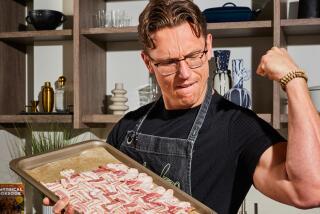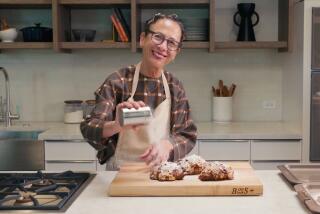Learning to Cook : Our Miss Cook
The first time I shared a kitchen experiment with someone--my little sister--I was 9 years old and I got a bad review. She shoved aside what I had made, fixed herself a bowl of Count Chocula and announced, âIâm going to tell Mom on you!â
And she did. âMom!â she cried as soon as my mother got home from work, âSister put cinnamon in the scrambled eggs!â
OK, so I put cinnamon in the scrambled eggs. At the time it seemed a reasonable thing to do. Iâd recently discovered French toast and thought I was adapting a classic dish--French toast without the toast.
Maybe I was inspired by my stepfather, a bachelor most of his life, who taught me how to make what he called âUtah-style eggsâ: hard-cooked eggs, smooshed with a fork or spoon, sprinkled with salt and pepper and topped with a cereal-bowlful of milk. The first time he made the eggs for my sister and me, we giggled with embarrassment for him--salt and pepper in milk? With eggs? But then we liked what we ate. Iâm sure it was this dish that made me a near-fearless eater.
Still, it would be years before Iâd discover that the world is full of wonderful things to eat made with what many Americans would consider odd combinations of ingredients. If, when I was 9, Iâd known about Paula Wolfertâs âCouscous and Other Good Food of Morocco,â I would have told my sister and mother about a chicken recipe that, among other things, calls for cinnamon and eggs. But instead, I had to figure out another way to impress them.
There was only one cookbook in the house: the âCulinary Arts Institute Encyclopedic Cookbook.â It was full of cheerful drawings--a male cucumber shaking hands with a female tomato--and lots of recipes, most of them intimidating.
And so, a lot of what I learned about food came from television. When Marlo Thomas as âThat Girlâ made bachelorette tomato soup--catsup and hot water--I made it too . . . and was bitterly disappointed. No matter how much catsup I put in the âsoup,â it still tasted like hot water. (My mother never did find out why we went through so much catsup that week.)
When, on âThe Brady Bunch,â Peter started walking around saying, âpork chops and applesauce,â in a modified Jimmy Cagney accent, I made sure we had applesauce on the table the next time my mother made pork chops. She was puzzled, but amused. I think she was getting used to my odd requests. When our local paper suggested making soup with the bones of a Thanksgiving turkey, I insisted that we keep that yearâs carcass. This absolutely bewildered my mother. She let me make the soup--which I thought was delicious--but the next year we threw out the turkey bones just as we always did.
I suppose the thing that most tried my motherâs patience was my white sauce phase. It was the one dish I learned from the âCulinary Arts Institute Encyclopedic Cookbookâ and to me, it was the coolest thing in the world. White sauce was sophisticated and, best of all, it was easy. There was always flour and butter and milk in the house. I took this as a mandate to make that white sauce again and again and again. Iâd pour it over chicken, Iâd pour it over noodles; I filled a baked potato with it, and once, I ate it with French fries.
Eventually, as my mother predicted, I grew bored with white sauce. I decided, if I was ever going to get my mother and my sister to eat my cooking, Iâd have to make something that they already liked. I decided to learn to make an omelet. The âEncyclopedic Cookbookâ was not much help. I didnât like the oven method called for in what the book called âpuffyâ omelet. And when I tried the French omelet, I just got a big mess--the eggs were soggy on the top, dried on the bottom. But I was impressed with the TV technique of âThe Galloping Gourmet.â He could flip an omelet.
Every time a cooking segment on omelets appeared on TV, Iâd pay attention, looking for tips on flipping. And every month, when my motherâs Better Homes and Gardens arrived, Iâd search the pages for omelet advice. I found dozens of contradictory opinions.
I donât remember where I found the two steps that enabled me to make my first successful omelet, but I do remember the instructions.
First, instead of milk, mix the eggs with a couple tablespoons of water. Next, when you pour the eggs into a hot, buttered pan run a fork through the uncooked eggs with a sort of Z-for-Zorro motion. This prevents the eggs from setting too quickly.
The first time I tried, I flipped the omelet and it tasted good. My mother and my sister were impressed.
More to Read
Eat your way across L.A.
Get our weekly Tasting Notes newsletter for reviews, news and more.
You may occasionally receive promotional content from the Los Angeles Times.











